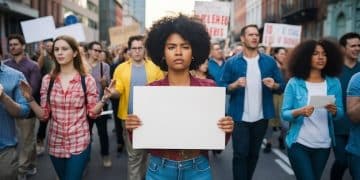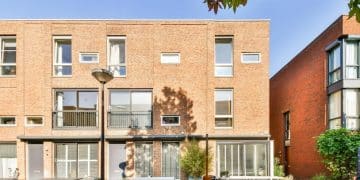Gentrification’s Impact: A Social Justice Debate on Low-Income Communities
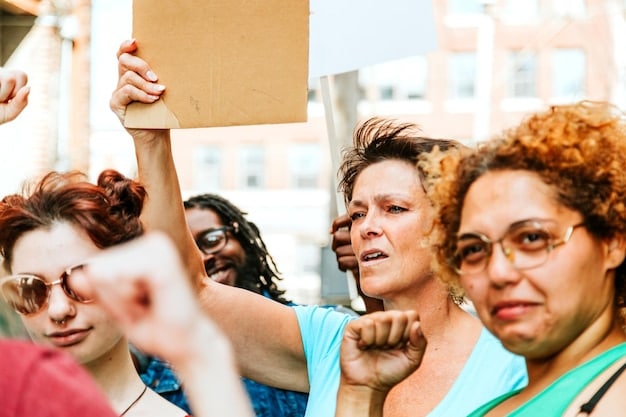
Analyzing the impact of gentrification on low-income communities reveals a complex social justice debate, balancing economic development with the displacement and cultural erasure of vulnerable populations.
The encroachment of affluence into historically low-income neighborhoods, a process known as analyzing the impact of gentrification on low-income communities: a social justice debate, sparks heated debates. While proponents tout economic revitalization and increased property values, critics decry displacement, cultural erasure, and the exacerbation of existing inequalities. Is gentrification a force for progress or a catalyst for injustice?
Understanding Gentrification: A Multifaceted Phenomenon
Gentrification is more than just new coffee shops and rising rents. It’s a complex process with deep roots in urban planning, economic policy, and social attitudes. Understanding its various facets is crucial for analyzing its true impact.
Gentrification typically involves an influx of wealthier residents into a lower-income or working-class neighborhood. This often leads to changes in the neighborhood’s character, including renovated housing, new businesses, and an increased demand for services, inevitably raising property values and living costs.
The Drivers of Gentrification
Several factors contribute to the process of gentrification, making it a multifaceted issue. Understanding these drivers can help in analyzing the phenomenon.
- Urban planning policies: Zoning regulations, infrastructure investments, and tax incentives can encourage or discourage gentrification in specific areas.
- Economic forces: The availability of capital, the demand for urban living, and the growth of service industries all play a role.
- Demographic shifts: Changes in population size, age, and household composition can influence neighborhood dynamics.
- Cultural trends: Preferences for walkable neighborhoods, proximity to amenities, and a desire for diverse communities can drive gentrification.
Understanding these drivers is essential for formulating effective policies that address the potential negative consequences of gentrification while harnessing its potential benefits.
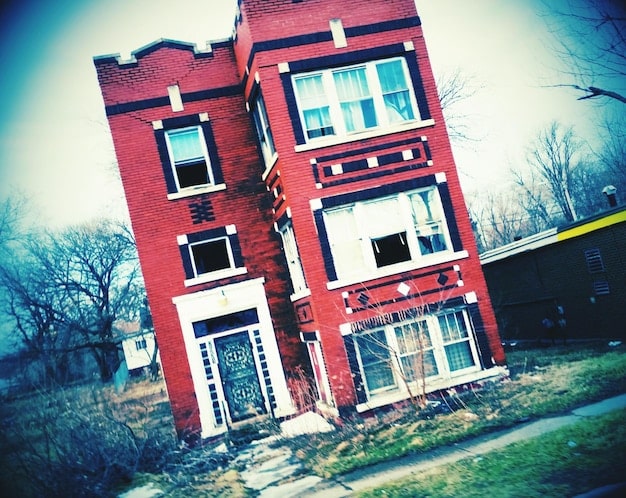
In conclusion, gentrification is a complex issue driven by a combination of factors, including urban planning policies, economic forces, demographic shifts, and cultural trends. Understanding these drivers is crucial for addressing its potential negative consequences and harnessing its potential benefits.
The Positive Impacts: Revitalization and Economic Growth
Gentrification isn’t all doom and gloom. It can bring positive changes to neglected neighborhoods, sparking economic growth and improving quality of life for some residents.
One of the oft-cited benefits of gentrification is the revitalization of decaying infrastructure. Investment in new housing, businesses, and public spaces can transform neglected areas into vibrant, thriving communities.
Economic Benefits of Gentrification
The influx of wealthier residents and businesses can bring significant economic benefits to gentrifying neighborhoods, stimulating growth and creating opportunities.
- Increased property values: Homeowners who have lived in the neighborhood for a long time may see their property values rise, allowing them to build wealth.
- New businesses and job creation: Gentrification often attracts new businesses, creating jobs for local residents.
- Improved tax base: Higher property values and increased economic activity can boost the local tax base, funding public services.
- Reduced crime rates: Some studies suggest that gentrification can lead to a decrease in crime rates due to increased security and investment in the area.
However, it’s important to note that these benefits are not always evenly distributed and can come at a cost for long-term residents.
In essence, while gentrification offers potential benefits such as economic growth and revitalization, these advantages must be carefully balanced against the potential negative impacts on existing residents and the community’s social fabric.
The Negative Impacts: Displacement and Cultural Erasure
The darker side of gentrification involves displacement and cultural erasure, which cause significant harm to low-income communities. Long-term residents are often forced to leave their homes, and the unique character of the neighborhood is lost.
Rising rents and property taxes can make it impossible for low-income residents to afford to stay in their homes. As wealthier residents move in, the demand for housing increases, driving up prices. This can lead to displacement, particularly for those on fixed incomes or with limited financial resources.
The Social Costs of Gentrification
Gentrification’s social costs are often overlooked, but they can have a profound impact on individuals and communities. It is important to take these costs into account when analyzing the process.
- Loss of affordable housing: The decrease in affordable housing options forces low-income residents to move to less desirable areas, often further from jobs and resources.
- Disruption of social networks: Displacement can break up established social networks and support systems, leading to social isolation and a loss of community.
- Cultural erasure: As new residents move in, the cultural character of the neighborhood can be diluted or erased, leading to a loss of identity and heritage.
- Increased inequality: Gentrification can exacerbate existing inequalities by concentrating wealth and resources in the hands of a few, while pushing low-income residents to the margins.
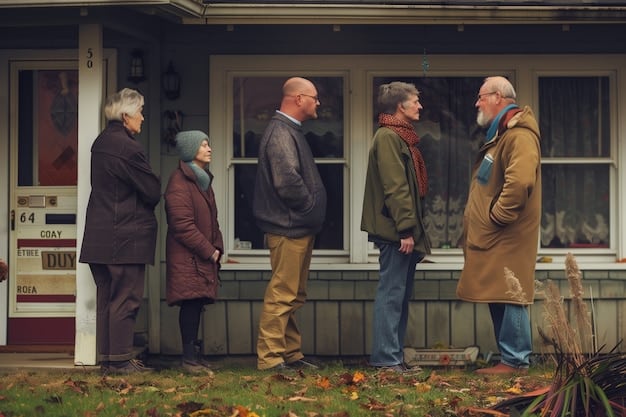
In conclusion, the negative impacts of gentrification, such as displacement and cultural erasure, often outweigh the potential economic benefits for low-income communities. These social costs need to be carefully considered when analyzing the overall impact of gentrification.
Analyzing Displacement: Who is Affected and How?
Displacement is a key concern when analyzing any gentrification process. Understanding who is affected and how it occurs is crucial for finding effective solutions.
Senior citizens on fixed incomes are particularly vulnerable to displacement. As property taxes rise, they may struggle to afford their homes, even if they have lived there for decades. Similarly, low-wage workers may find it difficult to compete with higher-income residents for affordable housing.
The Mechanisms of Displacement
Displacement can occur through various mechanisms, some more direct than others. Recognizing these mechanisms is essential for protecting vulnerable residents.
- Direct eviction: Landlords may evict tenants to renovate properties and charge higher rents to new residents.
- Rent increases: Landlords may raise rents to unaffordable levels, forcing tenants to move out.
- Property tax increases: Homeowners may be unable to afford rising property taxes, leading to foreclosure or the sale of their homes.
- Constructive eviction: Landlords may fail to maintain properties, creating unsafe living conditions that force tenants to leave.
These mechanisms create a climate of instability and uncertainty for long-term residents, particularly those on the lower end of the economic spectrum.
In summary, analyzing displacement involves recognizing vulnerable populations, understanding the mechanisms of displacement, and implementing policies to mitigate these impacts and ensure that existing residents are not forced to leave their homes due to rising costs.
Gentrification as a Social Justice Issue: Ethical Considerations
When we consider gentrification as a social justice issue, several ethical questions arise. It forces us to think about fairness, equity, and the rights of vulnerable populations.
At the heart of the issue is the question of who benefits from gentrification and who bears the costs. Is it fair for a few to profit from the displacement of many? Does economic development justify the erasure of cultural heritage? These questions demand careful ethical consideration.
Ethical Frameworks for Analyzing Gentrification
Applying ethical frameworks can help us analyze the moral dimensions of gentrification and guide our actions in a just and equitable way.
- Utilitarianism: This framework focuses on maximizing overall well-being. In the context of gentrification, it requires weighing the benefits of economic development against the harms of displacement.
- Deontology: This framework emphasizes moral duties and rights. It asks whether gentrification respects the rights of all individuals, including the right to housing and cultural preservation.
- Virtue ethics: This framework focuses on character and virtues. It asks whether gentrification policies and practices promote virtues such as compassion, fairness, and respect for others.
These ethical frameworks can illuminate the values and principles that should guide our approach to gentrification.
Ultimately, analyzing gentrification through a social justice lens requires us to consider the ethical implications of our actions and strive for solutions that are fair, equitable, and respectful of the rights and dignity of all members of the community.
Potential Solutions: Policies for Equitable Development
Addressing the negative impacts of gentrification requires a multi-pronged approach involving policies that promote equitable development and protect vulnerable residents. These policies should aim to balance economic growth with social justice.
One crucial step is to implement policies that preserve and expand affordable housing options. This can include rent control, inclusionary zoning, and investments in subsidized housing programs. These measures can help ensure that low-income residents are not priced out of their homes.
Strategies for Equitable Development
There are several effective strategies that can foster equitable development and mitigate the negative impacts of gentrification.
- Community land trusts: These organizations acquire land and hold it in trust for the benefit of the community, ensuring that housing remains affordable in perpetuity.
- Tenant protections: Laws that protect tenants from unfair evictions and rent increases can help stabilize neighborhoods and prevent displacement.
- Community benefits agreements: These agreements require developers to provide benefits to the community in exchange for development approvals, such as affordable housing, job training, or park improvements.
- Participatory planning: Involving residents in the planning process ensures that their voices are heard and that development projects are responsive to their needs and concerns.
Implementing these policies and strategies requires a collaborative effort involving government, community organizations, developers, and residents.
| Key Aspect | Brief Description |
|---|---|
| 🏘️ Gentrification | Influx of affluence into low-income areas. |
| 📈 Economic Impact | Increases property values and attracts new businesses. |
| 🚨 Displacement | Forces low-income residents out due to rising costs. |
| ⚖️ Social Justice | Raises ethical questions about fairness and equity in development. |
Frequently Asked Questions (FAQ)
▼
Gentrification is the process where wealthier people move into an existing urban district, leading to changes in the district’s character and culture, including increased property values and displacement of lower-income residents.
▼
The primary drivers include urban planning policies that encourage development, economic forces creating demand for urban living, demographic shifts in population, and cultural trends favoring walkable, amenity-rich neighborhoods.
▼
While it can bring economic benefits such as increased property values and new businesses, it often leads to displacement of long-term residents, loss of affordable housing, and the erasure of cultural heritage.
▼
Strategies include implementing rent control, inclusionary zoning, investing in subsidized housing, establishing community land trusts, and enacting stronger tenant protection laws.
▼
By involving residents in the planning process, forming community benefits agreements with developers, and focusing on policies that promote affordable housing and preserve cultural heritage, communities can strive for equitable outcomes.
Conclusion
Analyzing the impact of gentrification on low-income communities reveals a complex interplay of economic forces, social consequences, and ethical considerations. While it can bring certain benefits, it also poses significant challenges to vulnerable residents. By understanding the drivers and impacts of gentrification, and by implementing policies that promote equitable development, we can strive to create more just and inclusive communities for all.

